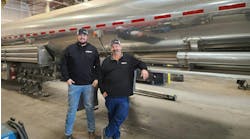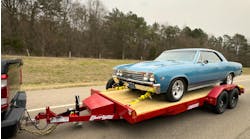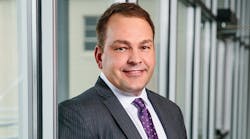Incoming Wabash National CEO Brent Yeagy says forward-looking investments in advanced materials and people, to say nothing of last fall’s purchase of Supreme Industries, have positioned the trailer maker for market leadership for many years to come.
“Wabash is getting ready to really change the world, in the context of trailer design, over the next three to five years,” Yeagy told Trailer/Body Builders in a wide-ranging interview at the Work Truck Show. “We have the capacity, we’re deploying capital right now and the [intellectual property] is in place. This is not a wish—this is happening.”
Yeagy, currently president and chief operating officer, takes over in June when CEO Dick Giromini steps down.
At the WTS exhibit area, Wabash featured a Final Mile Series truck body with new DuraPlate Honeycomb Core panels, both significantly lighter (by some 200 pounds) and more durable “than what the truck body industry is used to,” Yeagy explained.
The product is designed to stand out in the local delivery space, noted Senior Vice President and Group President, Final Mile Products Mike Pettit.
“When you start to talk about the durability benefits, no one has sold DuraPlate into the truck body space on a broad scale,” Pettit said. “So now we’re starting to do that. When you can also bring now comparable or better weight to what the traditional technologies are in the space, there’s a lot of excitement.”
The technology will also be offered through Supreme.
“The customer base is significantly more fragmented in the truck-body world than it is in the trailer space,” Pettit added. “Supreme has literally thousands of customers … so it makes perfect sense to pursue this technology with a Supreme product.”
Production of the truck body with the honeycomb technology is ramping up this year, with significant capacity available in 2019.
Yeagy also touted a production-ready, molded structural composite (MSC) technology reefer van. As shown just days before WTS at the Technology and Maintenance Council annual meeting in Atlanta, a limited initial run of trailers is headed to Werner Enterprises for fleet testing.
“This is a true, in-production 24,000-lb. floor in a reefer van, which now puts it in a dry-van load capability, with a dry-van rear opening. So from a back-haul efficiency standpoint, that provides our customers a tremendously flexible asset to improve back-haul efficiency, which is substantial,” Yeagy said. “The other thing that we wanted to highlight, and make sure our customers and the market understand, is that with 28% or greater thermal efficiency, we’re changing the residual-value profile of a refrigerated van … because the thermal unit can last longer with the same box.”
Also at TMC, Wabash announced its Cell Core DuraPlate technology, specifically within dry van applications, boasting a 350-pound weight savings with the same structural integrity and durability as a standard DuraPlate panel.
“You’re going to see these all coming to bear over the next several years,” Yeagy said.
Learning curve
Speaking more broadly, Yeagy touched on the Supreme integration, the evolving supply chain and his goals for the future.
“We’re excited about how the Supreme transition is going. Obviously, there’s a learning curve on both sides,” Yeagy said. “While we’ve been in the truck-body space for a couple years at Wabash, we’ve validated that having something on the scale of Supreme has enabled us to really understand and dive into what it means to be successful within this space.”
On the Supreme side, the emphasis has been on adapting to Wabash performance standards.
“They’ve begun to learn and understand to think about markets in an innovative fashion,” Yeagy said. “Supreme really has to understand and digest that we expect them to grow, do things differently, serve customers more fully. They’re learning what that means now.”
In terms of the impact of e-commerce on the trailer business, Yeagy anticipates “some level of impact” for traditional, long-haul movement of goods, but suggests bigger changes for the “middle-mile” segment.
“We’ll call it those lanes that move into the distribution center—that may be the most disrupted space. So what is that LTL-to-truck load ratio moving in, and are there more mixed loads? The truckload carriers really have to understand what that means for them, and this is something we looked at and started to think about three, four, five years ago,” he said. “Wabash has to be playing at all ends of the spectrum for us to be successful long-term and have a fully rounded-out strategy. Final mile allows us to do that. We’ve got truckload, we’ve got final mile, now we can play into best serving what we think the most disruptive part of it will be, which will be middle mile.”
The key to Wabash’s prolonged market leadership has been a willingness to invest in innovation for the long term.
“Just as we took and brought DuraPlate to market in 1995, that was an eight-year R&D process. It’s something that initially positioned Wabash extremely well to be the innovative leader in trailer design for the last 20 years,” Yeagy said. “We wouldn’t think anything less than what we’re doing right now. It’s a conscious choice that we’ve made to invest and to take the risk and the chance to bring something like this to life, and that sets us apart from any other trailer manufacturer. So we obviously are positioning this for the future of the company, in the multiple spaces in which we play.”
Asked about any particular initiatives or agenda for his tenure, Yeagy was quick to credit the outgoing Giromini for establishing a solid platform for future growth and success.
“When we look at the dynamics of Wabash National today, our responsibility now is to take that great foundation and to go faster in how we grow, how we deploy new innovation, and in the way that we conduct business. That’s going to be an area of focus for me and the company,” Yeagy said. “The other thing is that we’re going to win through people, and so you’re going to see a tremendous amount of focus in expanding the breadth and level of talent that we have within our organization. We have big ideas and therefore it takes great people to bring those ideas to life, and we’re committed to making that happen.”









